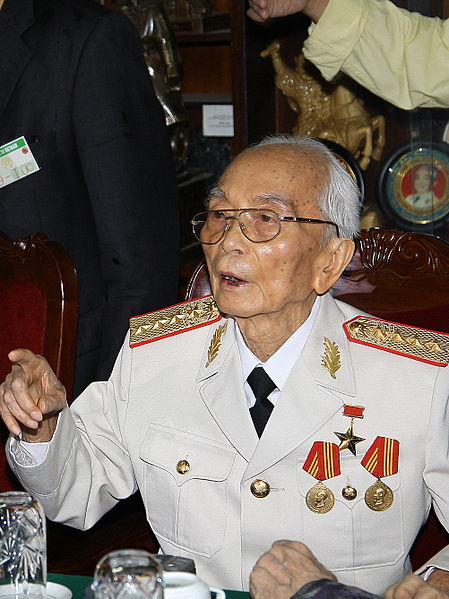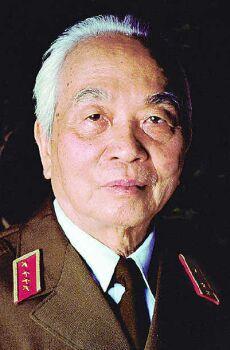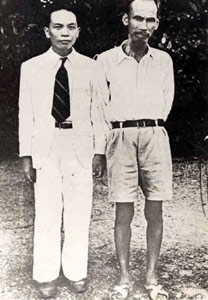<Back to Index>
- General of the Vietnam People's Army Vơ Nguyên Giáp, 1911
PAGE SPONSOR



Vơ Nguyên Giáp (August 25, 1911 - October 4, 2013) was a Vietnamese officer in the Vietnam People’s Army and a politician. He was a principal commander in two wars: the First Indochina War (1946 – 1954) and the Vietnam War (1960 – 1975). He participated in the following historically significant battles: Lạng Sơn (1950); Ḥa B́nh (1951 – 1952); Điện Biên Phủ (1954); the Tết Offensive (1968); the Easter Offensive (1972); and the final Hồ Chí Minh Campaign (1975). He was also a journalist, an interior minister in President Hồ Chí Minh’s Việt Minh government, the military commander of the Việt Minh, the commander of the Vietnam People’s Army (PAVN), and defense minister. He also served as Politburo member of the Lao Động Party.
He was the most prominent military commander, beside Hồ Chí Minh, during the war and was responsible for major operations and leadership until the war ended.
Giáp was born in the village of An Xá, Quảng B́nh Province. His father and mother, Vơ Quang Nghiêm and Nguyen Thi Kien, worked the land, rented some to neighbors, and lived a relatively comfortable lifestyle. At 14, Giáp became a messenger for the Haiphong Power Company and shortly thereafter joined the Tân Việt Cách Mạng Đảng, a romantically styled revolutionary youth group. Two years later, he entered Quốc Học (also known in English as the “National Academy”), a French - run lycée in Huế, from which two years later, according to his own account, he was expelled for having organized a student strike. Although he has denied it, Giáp is said to have also spent a few years in the prestigious Hanoian Lycée Albert Sarraut, where the local elite was educated to serve the colonial regime. He was apparently in the same class as Phạm Văn Đồng, future Prime Minister, who has also denied having studied at Albert Sarraut, and Bảo Đại, the last emperor of Annam. In 1933, at the age of 22, Giáp enrolled in the University of Hanoi.
Giáp was educated at the University of Hanoi where he gained a bachelor’s degree in politics, economics and law. After graduation, he taught history for one year at the Thăng Long School in Hanoi. Throughout most of the 1930s, Giáp remained a schoolteacher and a journalist, writing articles for Tien Dang, while actively participating in various revolutionary movements. He joined the Communist Party of Vietnam in 1931 and took part in several demonstrations against French rule in Indochina as well as having assisted in founding the Democratic Front in 1933. All the while, Giáp was a dedicated reader of military history and philosophy, revering Napoleon I and Sun Tzu (Vietnamese: Tôn Vũ). Vơ Nguyên Giáp was arrested in 1930 and served 13 months of a two year sentence at Lao Bảo Prison. During the Popular Front years in France, he founded Hon Tre Tap Moi, an underground socialist newspaper. He also founded the French-language paper Le Travail (on which Phạm Văn Đồng also worked). In 1939 he married Nguyễn Thị Quang Thái, another socialist. She bore him a daughter, Hong Anh. When France outlawed communism during the same year, Giáp fled to China together with Phạm Văn Đồng where he joined up with Hồ Chí Minh, the leader of the Vietnam Independence League (Việt Minh). While he was in exile, his wife, sister, father and sister - in - law were arrested, tortured and later executed by the French colonial authorities. His daughter is also believed to have perished in prison due to neglect.
He returned to Vietnam in 1944, and between then and 1945 he helped organize resistance to the Japanese occupation forces. When the Japanese surrendered to the Allies in August 1945, the Japanese decided to allow nationalist groups to take over public buildings while keeping the French in prison as a way of causing additional trouble to the Allies in the postwar period. The Việt Minh and other groups took over various towns and formed a provisional government in which Giáp was named Minister of the Interior.
In September 1945, Hồ Chí Minh announced the formation of the Democratic Republic of Vietnam. Unknown to the Việt Minh, President Harry S. Truman, Prime Minister Winston Churchill and Premier Joseph Stalin had already decided the future of postwar Vietnam at a summit meeting at Potsdam. They agreed that the country would be occupied temporarily to get the Japanese out; the northern half would be under the control of the Nationalist Chinese and the southern half under the British.
After the Second World War (WWII),
France attempted to reestablish control over Vietnam. In January 1946,
Great Britain agreed to remove her troops, and, later that year, the
Chinese left Vietnam in exchange for a promise from France that she
would give up her rights to territory in China.
In late 1945, after the defeat of Japan in WWII, the French returned to reclaim Indochina. Sporadic fighting quickly became a general war between the Democratic Republic of Vietnam (Việt Minh) and the French on December 19, 1946. The first few years of the war involved mostly a low level, semi - conventional resistance fight against the French occupying forces. However, after the Chinese communists reached the northern border of Vietnam in 1949 and the Vietnamese destruction of French posts there, the conflict turned into a conventional war between two armies equipped with modern weapons supplied by the United States and the Soviet Union.
French Union forces included colonial troops from many parts of the French former empire (Moroccan, Algerian, Tunisian, Laotian, Cambodian, Vietnamese and Vietnamese ethnic minorities), French professional troops and units of the French Foreign Legion. The use of metropolitan (i.e., from France itself) recruits was forbidden by the governments to prevent the war from becoming even more unpopular at home. It was called the "dirty war" (la sale guerre) by supporters of the Left in France and intellectuals (including Sartre) during the Henri Martin Affair in 1950.
When
it became clear that France was becoming involved in a long drawn out
and so far not very successful war, the French government tried to
negotiate an agreement with the Việt Minh. They offered to help set up a
national government and promised that they would eventually grant
Vietnam its independence. Hồ Chí Minh and the other leaders of
the Việt Minh did not trust the word of the French and continued the
war.
French public opinion continued to move against the war. There were five main reasons for this:
- Between 1946 and 1952 many French troops had been killed, wounded, or captured.
- France was attempting to build up her economy after the devastation of the Second World War. The cost of the war had so far been twice what they had received from the United States under the Marshall Plan.
- The war had lasted for seven years and there was still no sign of an outright French victory
- A growing number of people in France had reached the conclusion that their country did not have any moral justification for being in Vietnam.
- Parts of the French left supported the goals of the Việt Minh to form a socialist state.
While growing stronger in Vietnam, the Việt Minh also expanded the war and lured the French to spread their force to remote areas such as Laos. In December 1953, Navarre set up a defensive complex at Điện Biên Phủ, which attempted to block the aids transportation route passing through Laos. He surmised that in an attempt to reestablish the route to Laos, Giáp would be forced to organize a mass attack on the French forces at Điện Biên Phủ, where he hoped to have advantage in a conventional battle.
Giáp took up the French challenge. While the French dug in at their outpost, the Việt Minh were also preparing the battlefield. Divergent attacks in other areas, diverted French air logistics elsewhere. Giáp ordered his men to secretly pull their artillery by hand, 24 105mm howitzers to hollows on the inner hill sides of Điện Biên Phủ for providing them cover from French aircraft and counter - attacks from French artillery.
With antiaircraft guns supplied by the Soviet Union, Giáp was able to severely restrict the ability of the French to supply their forces, and forced them to inaccurately drop supplies from high altitude to the besieged areas. Giáp chose to surround the outpost and ordered his men to dig a trench system that encircled the French. From the outer trench, other trenches and tunnels were dug inward towards the center. The Việt Minh were now able to move in close to the French troops defending Điện Biên Phủ.
When Navarre realized that he was trapped, he appealed for help. The United States was approached and some advisers suggested the use of tactical nuclear weapons against the Việt Minh, but this was never seriously considered. Another suggestion was that conventional air raids would be enough to scatter Giáp’s troops. U.S. President Dwight D. Eisenhower, however, refused to intervene unless the British and other Western allies agreed. Churchill declined, claiming that he wanted to wait for the outcome of the peace negotiations taking place in Geneva, Switzerland, before becoming involved in escalating the war.
On 13 March 1954, Giáp launched his offensive. For 54 days, the Việt Minh seized position after position, pushing the French until they occupied only a small area of Điện Biên Phủ. Colonel Piroth, the artillery commander, blamed himself for the destruction of French artillery superiority. He told his fellow officers that he had been "completely dishonored" and committed suicide with a hand grenade. General De Castries, French Commander in Điện Biên Phủ, was captured alive in his bunker. The French surrendered on May 7. Their casualties totaled over 2,200 men, 5,600 wounded and 11,721 taken prisoner. The following day the French government announced that it intended to withdraw from Vietnam.
Giap's
victory over the French crushed the legend of Western invincibility and
thus opened a new era in the struggles for national independence
against colonialism. With this victory, the name of Vo Nguyen Giap
became identified throughout Africa and Latin America with the defeat of
colonialism.
Giáp remained commander in chief of the People’s Army of Vietnam throughout the war against the United States. During the conflict, he oversaw the expansion of the PAVN from a small self defense force into a large conventional army, equipped by its communist allies with considerable amounts of relatively sophisticated weaponry, although this did not in general match the weaponry of the Americans. Giáp has often been assumed to have been the planner of the Tết Offensive of 1968, but this appears not to have been the case. The best evidence indicates that he disliked the plan, and when it became apparent that Lê Duẩn and Văn Tiến Dũng were going to push it through despite his doubts, he left Vietnam for medical treatment in Hungary, and did not return until after the offensive had begun. Although this attempt to spark a general uprising against the southern government failed militarily, it turned into a significant political victory by convincing the American politicians and public that their commitment to South Vietnam could no longer be open ended. Giáp later argued that the Tết Offensive was not a "purely military strategy" but rather part of a "general strategy, an integrated one, at once military, political and diplomatic."
Peace talks between representatives from the United States, the Republic of Vietnam, the Democratic Republic of Vietnam, and the NLF began in Paris in January 1969. President Richard M. Nixon, like President Lyndon B. Johnson before him, was convinced that a U.S. withdrawal was necessary, but five years would pass before the last American troops left South Vietnam. In October 1972, the negotiators came close to agreeing to a formula to end the conflict. The plan was that the last U.S. troops would withdraw from Vietnam in exchange for a ceasefire and the return of American prisoners held by Hà Nội. It was also agreed that the governments in North and South Vietnam would remain in power until new elections could be arranged to unite the whole country. Although the casualties in the Nguyễn Huệ Offensive during the spring of 1972 was high, PAVN was able to gain a foothold in territorial Southern Vietnam from which to launch future offensives.
Although
U.S. troops would leave the country, PAVN troops could remain in their
positions in the south. In an effort to put pressure on both North and
South Vietnam during the negotiations, President Nixon ordered a new
series of air raids on Hà Nội and Hải Pḥng, codenamed Operation Linebacker II. Following the failure of the operation, on 27 January 1973, Nixon agreed to sign the Paris Peace Accords that had been proposed in October.
The last U.S. combat troops left in March 1973. Despite the treaty, there was no letup in fighting. South Vietnamese massive advances against the NLF controlled territory inspired their opponents to change their strategy. In March, communist leaders met in Hanoi for a series of meetings to hammer out plans for a massive offensive against the South. In June 1973, the U.S. Congress passed the Case - Church Amendment to prohibit further U.S. military involvement, so the PAVN Hochiminh trail were able to operate normally without fear of U.S. bombing.
South Vietnamese President Nguyễn Văn Thiệu appealed to Nixon for continued financial aid. Nixon was sympathetic but the U.S. Congress was not, and the move was blocked. At its peak, U.S. aid to South Vietnam had reached $30 billion a year. By 1974, it had fallen to US$1 billion. Starved of funds, Thiệu’s government had difficulty paying even the wages of its army, and desertions became a problem. On the other side, the PAVN was also having to bring up obsolete equipment such as the SU-100 tank destroyers to prepare for their final offensive.
In the spring of 1975, Giáp sent four star General Văn Tiến Dũng to launch the deadliest attack on Buôn Ma Thuột. This town sat at the intersection of the important routes of Central Highland and it was a weak point for the enemy forces. The sudden strike frightened the southern leaders and generals, worsened the Army of the Republic of Vietnam (ARVN) morale, and shook the ARVN defense system.
Giáp sent General Lê Trọng Tấn to launch a series of attacks against Đà Nẵng, where nearly 100,000 well equipped troops of the best southern divisions were camped. In three days, Đà Nẵng was seized. Giáp appointed General Văn Tiến Dũng as 1st Commander and General Lê Trọng Tấn as 2nd Commander of the "Hồ Chí Minh Campaign", a massive conventional operation that utilized armor and heavy artillery. The goal of the operation was to take over Saigon from two directions, Central Highland and coastal no.1 highway. These attacks were done in coordination with General Lê Đức Anh and Snr. Lt. General Trần Văn Trà. After important areas such as Buôn Ma Thuột, Đà Nẵng and Huế were lost in March, panic swept through the ARVN and its high command. President Thiệu attempted to abandon the northern half of the nation while pulling his troops back to defensive positions in the south.
Under guidelines from Giáp, General Lê Trọng Tấn’s force was first to enter Saigon and Tấn captured Dương Văn Minh alive. Minh was the last president of the Vietnamese Republic in the capital of Saigon on 30 April 1975. Soon afterward, the Socialist Republic of Vietnam was established. In the new government, Giáp maintained his position as Minister of National Defense and he was made Deputy Prime Minister in July 1976. He was removed from this post at the Defense Ministry in 1980 and was also removed from his position in the Politburo in 1982. He remained on the Central Committee and Deputy Prime Minister until 1991.
Giáp has also written extensively on military theory and strategy. His works include Big Victory, Great Task; People's Army, People's War "Điện Biên Phủ; and We Will Win. Historian Stanley Karnow described him as ranking with "Wellington, Grant, Lee, Rommel and MacArthur in the pantheon of great military leaders".
In 1995, former U.S. Secretary of Defense Robert McNamara met Giáp to ask what happened on 4 August 1964 in the second Gulf of Tonkin Incident. "Absolutely nothing", Giáp replied. The incident, that served President Johnson as a pretext to step up U.S. involvement in the conflict, had been imaginary, although it had not started as a deliberate fabrication.
In 2010, Giáp became a prominent critic of bauxite mining in Vietnam following government plans to open large areas of the Central Highlands to the practice. Giáp indicated that a 1980s study led experts to advise against mining due to severe ecological damage.